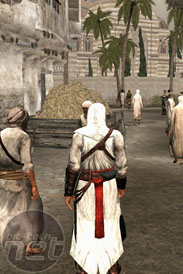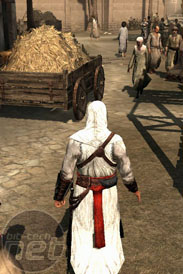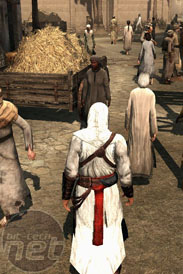
Graphics Analysis
At bit-tech we’re well aware that we have a slightly more technical and graphical bent than a lot of other sites, but even for us it’s a little unusual to focus on the graphical testing from the off.What can we say though? Given that the only incremental advances in content over the console version, the graphics are pretty much the main draw of Assassin’s Creed: Director’s Cut – especially when you see how pretty the game is.
Besides, the lofty system requirements have got our interests piqued – so check out our graphical analysis below to see what the game looks like on various different settings. If you know your under powered rig is only going to be capable of running the game on Low, then this’ll show you what you can expect visually from that setting.
Graphical Detail
Assassin’s Creed on the PC has an unusually vague system for managing the graphics and there’s really only a handful of different settings. We’ll tick through them each in turn, but to start with there’s Graphical Detail. It comes in four flavours, each with a number. The higher the number, the better the detail.
First off, if you’re interested in framerates, know that we didn’t have any performance problems at all with Assassin’s Creed: Director’s Creed. Our gaming system houses an X6800 CPU at 2.93GHz and an 8800 Ultra with 3GB of RAM and Vista underneath and we had solid framerates all the way through running at 1,920 x 1,200. Check the enlarge pictures for specifics.
The first thing you’ll notice the Detail setting controls is the number of people visible on the street from a distance. This has a huge impact on the mood of the game and, given that Altair is forever barging through and blending into crowds, impacts gameplay too. You want this setting as high as you can put it, especially since it also affects the extra details on buildings and merchant stands.
Graphical Quality
Hmm, another oh-so-vague descriptor. First there’s Graphical Detail, now there’s Graphical Quality. The difference between the two isn’t really defined anywhere – though fiddling with the settings, again numbered 1-4, reveals a lot more about the inner workings of the setting. Check the pictures for the full low-down.The first thing to look at here is the lighting because the difference between setting 1 and setting 2 is really quite extraordinary. The lower settings give only static or flat lighting effects, with the lowest making the game look like it’s stuck on Fullbright. Go higher though and more shades, more colours and more depth start to work into the scene.
The detail on certain models also seems affected by this setting – watch the hay in the cart to see what we mean. On the higher settings the model for the hay is more complex and less jagged, though on lower settings the
In other words, if you only tinker with one setting in Assassin’s Creed: Director’s Cut then make sure it is this one – it has the most mammoth effect on the look of the game and, though Assassin’s Creed is definitely playable on the lowest settings, it’s not exactly the most ideal circumstance for gaming.

MSI MPG Velox 100R Chassis Review
October 14 2021 | 15:04

















Want to comment? Please log in.